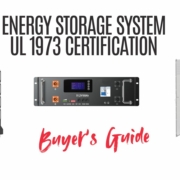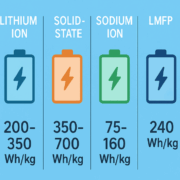What Are Fossil Fuels? Types, Uses, and Environmental Impact
Fossil fuels have powered the modern world for over a century. From lighting our homes to fueling our vehicles and running industries, fossil fuels have been at the heart of global energy consumption. But what exactly are fossil fuels? How do they work, and why is there a growing movement to move away from them?
This blog post explores what fossil fuels are, their types, uses, and the environmental impact they bring.
What Are Fossil Fuels?
Fossil fuels are natural energy sources formed from the decomposed remains of ancient plants and animals. Over millions of years, heat and pressure beneath the Earth’s surface transformed these organic materials into coal, oil, and natural gas.
They are called “fossil” fuels because they originate from fossils — the preserved remains of prehistoric life.
Types of Fossil Fuels
There are three main types
1. Coal
Coal is a black or brownish-black sedimentary rock that is burned for electricity and heat. It is the most abundant fossil fuel and has been used for centuries to power industries and generate electricity.
Types of coal include:
- Peat
- Lignite (brown coal)
- Bituminous coal
- Anthracite (hard coal)
2. Crude Oil (Petroleum)
Oil is a liquid fossil fuel that is refined into various products like gasoline, diesel, jet fuel, and lubricants. It is found deep underground and extracted through drilling.
Common petroleum products include:
- Petrol (Gasoline)
- Diesel
- Kerosene
- LPG (Liquefied Petroleum Gas)
3. Natural Gas
Natural gas is a gaseous fossil fuel made primarily of methane. It is used for cooking, heating, and electricity generation and is considered cleaner than coal and oil.
Forms of natural gas:
- Compressed Natural Gas (CNG)
- Liquefied Natural Gas (LNG)
Common Uses of Fossil Fuels
Deeply integrated into daily life and the global economy.
1. Electricity Generation
Coal and natural gas are widely used in thermal power plants to generate electricity.
2. Transportation
Petrol, diesel, and jet fuel power cars, trucks, ships, and airplanes.
3. Heating and Cooking
Natural gas is commonly used for residential and commercial heating, as well as cooking.
4. Industrial Applications
Fossil fuels are used in manufacturing, chemical production, steelmaking, cement production, and more.
5. Petrochemicals
Many plastic products and synthetic materials are derived from petroleum.
Why Are Fossil Fuels Problematic?
Despite their usefulness, these fuels come with serious drawbacks, especially concerning the environment.
1. Air Pollution
Burning fossil fuels releases pollutants like sulfur dioxide (SO₂), nitrogen oxides (NOx), and particulate matter into the air. These pollutants cause respiratory illnesses, smog, and acid rain.
2. Greenhouse Gas Emissions
These fuels emit large amounts of carbon dioxide (CO₂), a greenhouse gas responsible for climate change and global warming.
3. Global Warming
Excessive use of these fuels has significantly increased global temperatures, causing rising sea levels, melting ice caps, and extreme weather.
4. Water Pollution
Oil spills and coal mining operations often pollute water bodies, affecting marine life and human health.
5. Non-Renewable Nature
They are finite. Once depleted, they cannot be replenished in a human timeframe.
The Transition to Renewable Energy
- Solar energy
- Wind energy
- Hydropower
- Geothermal energy
- Biomass
Renewable sources are clean, sustainable, and infinite — making them a critical part of the future energy mix.
Fossil Fuels vs Renewable Energy
| Feature | Fossil Fuels | Renewable Energy |
|---|---|---|
| Source | Finite (coal, oil, gas) | Infinite (sun, wind, etc.) |
| Emissions | High CO₂ and pollutants | Minimal or zero emissions |
| Environmental Impact | Severe | Low |
| Operating Cost | Increasing over time | Decreasing with innovation |
| Sustainability | Not sustainable | Sustainable |
Should We Stop Using Fossil Fuels Completely?
That’s not immediately possible. these fuels still provide over 70% of global energy. But a gradual reduction in their use, combined with increased investment in renewable energy, is the best path forward.
Governments, industries, and individuals all play a role in transitioning to cleaner alternatives.
FAQs About Fossil Fuels
❓ What is the main problem with fossil fuels?
They emit harmful gases that cause air pollution and climate change.
❓ Are fossil fuels renewable?
No, they are non-renewable and take millions of years to form.
❓ Can we live without fossil fuels?
Not right now, but with smart planning, technology, and investment in renewables, we can reduce our dependence over time.
❓ Which fossil fuel is the cleanest?
Natural gas is considered the cleanest fossil fuel, but it still emits CO₂.
❓ Why do we still use fossil fuels?
They are currently cheaper, widely available, and infrastructure for them already exists.
Final Thoughts
Fossil fuels helped build the modern world, but they also threaten its future. Understanding their role, benefits, and dangers is the first step toward building a cleaner, greener planet.
UL 1973 Certification: The Safety Standard for Modern Battery Systems
As energy storage technologies power everything from homes to large-scale grids, safety and compliance have become non-negotiable. Among the most important safety benchmarks is UL 1973 certification, the globally recognized standard for stationary batteries and energy storage systems.
This certification validates that a battery has passed rigorous safety and performance tests, ensuring it can operate reliably under real-world conditions. For manufacturers, system integrators, and project developers, achieving UL 1973 certification is not only about compliance—it is about protecting customers, enabling market access, and building trust.
What Is UL 1973 Certification?
UL 1973, formally titled “Batteries for Use in Stationary, Vehicle Auxiliary Power, and Light Electric Rail Applications,” defines the testing requirements for rechargeable batteries used in non-automotive settings.
In simpler terms, if you are producing a Battery Energy Storage System (BESS) or a stationary backup solution, UL 1973 is the certification you need to prove safety.
The standard covers:
- Electrical safety (short-circuit, overcharge, abnormal charging)
- Mechanical safety (vibration, shock, impact resistance)
- Thermal safety (temperature cycling, fire resistance, thermal runaway prevention)
- Environmental durability (humidity, corrosion, altitude testing)
👉 Related Reading: Difference Between BESS and ESS
Why UL 1973 Matters for Battery Manufacturers and Integrators
Battery failures are not just technical risks—they carry financial, legal, and reputational consequences. By obtaining UL 1973 certification:
- Market Access: Many regions, including North America, require UL compliance before commercialization.
- Customer Confidence: Certified systems are trusted more by utilities, C&I customers, and regulators.
- Reduced Liability: Certification demonstrates due diligence in meeting safety requirements.
- Integration with Other Standards: UL 1973 certification is often a prerequisite or complement to UL 9540 for full energy storage system compliance.
👉 Learn More: UL 9540 vs. UL 9540A: What’s the Difference?
Key Tests in UL 1973 Certification
To achieve certification, batteries undergo a wide range of evaluations. Some of the most critical include:
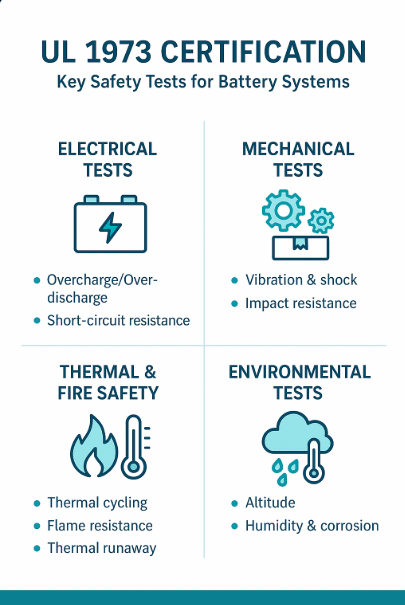
1. Electrical Abuse Tests
- Overcharge / Over-discharge – Verifies how cells handle extreme electrical conditions.
- Short-circuit resistance – Ensures protective circuits prevent hazards.
2. Mechanical Tests
- Vibration and shock testing – Simulates transportation and installation stresses.
- Impact resistance – Evaluates casing and module integrity.
3. Thermal & Fire Safety
- Thermal cycling – Repeated heating and cooling to test durability.
- Flame resistance – Verifies the system’s ability to resist ignition.
- Thermal runaway testing – Ensures proper containment under failure.
4. Environmental Tests
- Altitude testing – For high-elevation installations.
- Humidity and corrosion tests – Verifies performance in harsh climates.
👉 Related Reading: IEC Certifications for BESS
UL 1973 vs. Other Battery Standards
Many companies confuse UL 1973 with other standards. Here’s how it fits into the bigger picture:
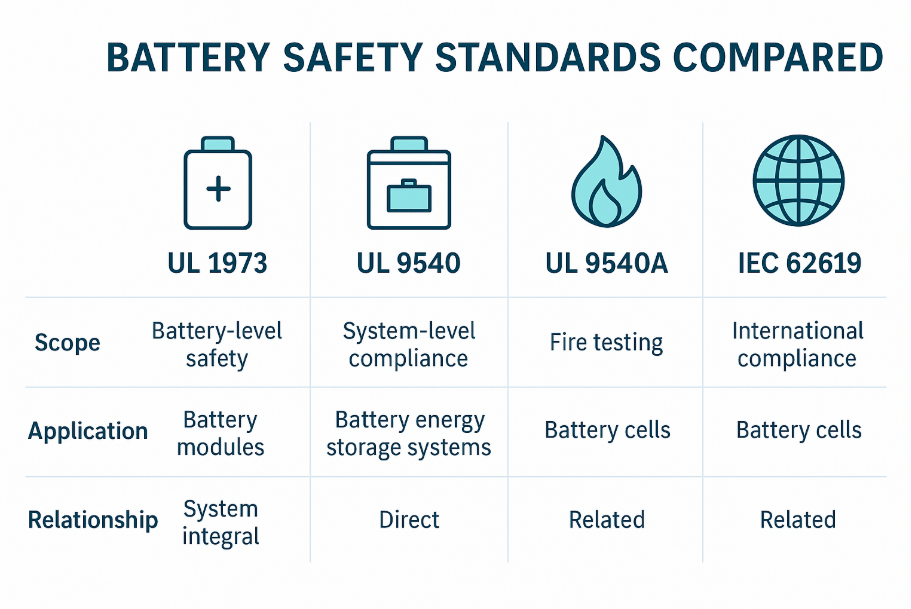
| Standard | Scope | Application | Relationship |
|---|---|---|---|
| UL 1973 | Stationary & rail batteries | Cell & module level | Foundation safety testing |
| UL 9540 | Energy storage systems | System-level BESS | Requires UL 1973-certified components |
| UL 9540A | Fire safety testing | Propagation & thermal runaway | Complements UL 1973 |
| IEC 62619 | International battery safety | Global markets | Often paired with UL for dual compliance |
👉 See Our Guide: UL 9540 Certification Explained
Challenges in Obtaining UL 1973
While certification is essential, the path can be complex. Common challenges include:
- Long testing timelines (6–12 months depending on lab capacity)
- High costs for prototype testing and certification cycles
- Design changes triggered by failures in early testing
- Documentation requirements (schematics, safety analysis, BMS reports)
Sunlith Energy helps clients streamline compliance by aligning battery designs with UL requirements early in the product development cycle.
How Sunlith Energy Supports UL 1973 Certification
At Sunlith Energy, we don’t just deliver battery solutions—we ensure they are market-ready and compliant. Our support includes:
- Design consulting – Ensuring your battery pack meets UL 1973 requirements from the ground up.
- Pre-certification testing – Identifying weak points before official lab submission.
- Documentation support – Preparing technical files, test reports, and safety manuals.
- Partnership with certified labs – Speeding up the testing and approval process.
👉 Contact Us: Sunlith Energy
FAQs: UL 1973 Certification
Q1. What is UL 1973 certification?
It is a safety certification for stationary and rail-use rechargeable batteries that validates performance under electrical, mechanical, and thermal stress.
Q2. Is UL 1973 mandatory for all batteries?
No, it applies primarily to stationary and auxiliary power systems, not automotive traction batteries (those follow UL 2580).
Q3. How long does certification take?
Typically 6–12 months, depending on battery complexity and lab availability.
Q4. How does UL 1973 relate to UL 9540?
UL 1973 ensures the safety of the battery itself, while UL 9540 covers the entire storage system. Most UL 9540 certifications require UL 1973-approved components.
Q
Final Thoughts
In the competitive energy storage landscape, UL 1973 certification is more than just a box to check—it is your gateway to trust, compliance, and market success. Whether you’re developing a new stationary storage solution or scaling up production, aligning with this standard protects your customers, your business, and your brand.
At Sunlith Energy, we combine technical expertise with compliance experience to help you achieve certification faster and more cost-effectively.
👉 Ready to take your battery system to the next level? Talk to Sunlith Energy today.
From Kilograms to Kilowatt-Hours: Understanding Battery Energy Density for Solar Storage
Why Energy Density Matters in Solar Storage
Battery technology has become the beating heart of modern solar energy systems. Whether in residential rooftops, commercial facilities, or grid-scale storage projects, the ability to store energy efficiently defines both performance and cost-effectiveness. One of the most important performance metrics is battery energy density.
Put simply, energy density tells us how much energy a battery can store for its weight or volume. For solar storage, higher energy density means more power in smaller, lighter systems—a game-changer for homeowners with limited space or businesses looking to maximize efficiency.
In this guide, we’ll break down what energy density means, how different battery chemistries compare, and what the future holds for solar energy storage.
What Is Battery Energy Density?
Energy density measures how much energy a battery can hold in relation to its mass (Wh/kg) or volume (Wh/L). These two forms are known as:
- Gravimetric energy density (Wh/kg): Energy per unit of mass.
- Volumetric energy density (Wh/L): Energy per unit of volume.
For example:
- A lithium-ion battery with 250 Wh/kg can deliver 250 watt-hours of energy for every kilogram of weight.
- A higher-density battery, say 400 Wh/kg, could provide nearly double the energy at the same weight.
In solar applications, both matter. Rooftop solar storage systems often care more about volume (space-saving in tight homes), while commercial and utility-scale solutions lean on mass efficiency for easier transport and installation.
Current Energy Densities: Lithium-Ion Leads Today
Lithium-ion (Li-ion) batteries dominate the energy storage market today—and for good reason.
- Typical range: 200–300 Wh/kg
- High-performance versions: 300–350 Wh/kg
- Theoretical limit: 400–500 Wh/kg
These values have been improving steadily. Thirty years ago, Li-ion cells were only around 80 Wh/kg. Today, premium designs push past 300 Wh/kg, delivering more than triple the performance at dramatically lower costs.
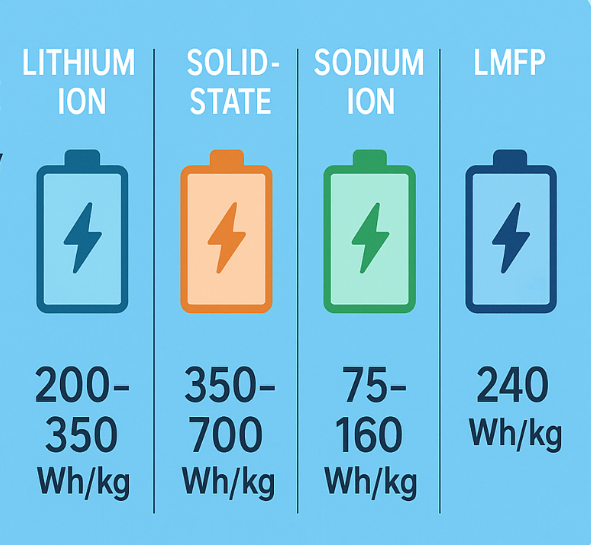
For Sunlith Energy customers, this means that a modern lithium-based solar storage system can provide longer backup times, faster charging, and more compact designs compared to older technologies like lead-acid.
Beyond Lithium-Ion: New Chemistries on the Horizon
While lithium-ion dominates today, researchers and manufacturers are racing to improve energy density through new chemistries. Let’s explore some of the most promising options.
Solid-State Batteries
- Energy Density: 350–700 Wh/kg (potential)
- Advantages: Higher density, safer (non-flammable solid electrolytes), faster charging.
- Challenges: Manufacturing complexity, high costs, scaling up.
Solid-state batteries are already moving from lab to pilot production, with companies like Toyota and Ion Storage Systems leading development. For solar storage, their promise lies in more compact, safer, and longer-lasting home and commercial systems.
Sodium-Ion Batteries
- Energy Density: 75–160 Wh/kg
- Advantages: Abundant raw materials, lower cost, better cold-weather performance.
- Challenges: Lower density compared to lithium-ion.
Although sodium-ion cannot compete with lithium-ion in density, they shine in affordable large-scale storage and cold climates, making them ideal for certain solar projects.
Lithium Manganese Iron Phosphate (LMFP)
- Energy Density: ~240 Wh/kg at cell level
- Advantages: Safer and more affordable than high-density lithium chemistries.
- Use Case: Perfect balance of cost, safety, and density for residential solar storage.
Semi-Solid and Sodium-Air Prototypes
- Semi-solid: ~270 Wh/kg today; safer, more stable for EVs and solar systems.
- Sodium-air: Theoretical >1,000 Wh/kg; still experimental, but could one day power long-duration off-grid solar or even electric aircraft.
Why Energy Density Isn’t Everything
It might sound like higher energy density always equals better—but in real-world solar applications, balance matters.
- Safety: High-density chemistries often face overheating risks. For homes, stability may outweigh raw density.
- Cost: A 700 Wh/kg solid-state battery may be incredible, but if it costs 10× more than today’s lithium-ion, it won’t make sense for most solar projects.
- Cycle Life: Batteries with slightly lower density but longer lifespan (like LFP or LMFP) can be more cost-effective over time.
- Temperature Performance: Sodium-ion’s resilience in cold climates may be more valuable than high density for certain markets.
For Sunlith Energy, the real value lies in matching the right battery chemistry to each customer’s needs—whether residential, commercial, or utility-scale.
The Evolution of Battery Economics
The story of battery energy density is also a story of economics. Over the past 30 years:
- Energy density has increased fivefold.
- Battery costs have dropped by over 90%.
- Global deployment has surged, especially in renewable storage.
This cost-density curve has transformed solar from a niche technology into a mainstream energy solution. Homeowners now enjoy affordable batteries that keep lights on during outages, while businesses leverage solar storage to cut peak demand costs.
What the Future Holds for Solar + Storage
Looking ahead, battery energy density will continue to shape solar energy adoption:
- Compact, High-Power Home Systems – Future households may install sleek, wall-mounted systems delivering twice today’s storage in half the space.
- Affordable Community Storage – Sodium-ion and LMFP could bring down costs, enabling microgrids and rural electrification.
- Grid Flexibility – Higher density batteries will support longer-duration storage, balancing renewables at utility scale.
- Sustainability First – Future solutions won’t just chase density; they’ll balance safety, recycling, and ethical sourcing.
For Sunlith Energy, this means staying at the forefront of new chemistries, while continuing to deliver reliable, efficient, and customer-focused solar storage solutions today.
Conclusion: Choosing the Right Battery for Your Solar Future
Battery energy density is a critical factor in designing solar + storage systems—but it’s not the only one. The best solution balances density with safety, cost, cycle life, and environmental fit.
At Sunlith Energy, we believe the future of solar storage lies in smart integration: pairing the right chemistry with each unique project. Whether it’s a compact lithium-ion battery for a city apartment, a cost-efficient sodium-ion solution for cold climates, or next-generation solid-state storage for commercial clients, our mission is to deliver power that works for your future.
Breaking the Barriers: The Biggest UAV Battery Challenges & Game-Changing Solutions
UAV Battery: Unmanned Aerial Vehicles (UAVs), or drones, have revolutionized industries from agriculture to defense, logistics, and even entertainment. However, their full potential is still shackled by one crucial limitation—battery technology. The performance, range, and overall efficiency of UAVs are only as strong as the batteries that power them.
In this blog, we dive into the biggest hurdles that UAV batteries face, why they exist, and the cutting-edge innovations that could break these barriers.
1. The Flight Time Dilemma: How Long Can Drones Stay in the Air?
The Challenge:
The Achilles’ heel of most UAVs is their short flight duration. Despite advances, commercial drones still max out at 20 to 60 minutes on a single charge—nowhere near enough for long-range missions, surveillance, or extended delivery routes.
Why It Happens:
- Low energy density: Current battery tech lacks the storage capacity needed for long flights.
- Power-hungry operations: UAVs consume large amounts of energy for flight, navigation, and onboard equipment.
- Weight vs. capacity tradeoff: More battery capacity means added weight, which ironically reduces efficiency.
What’s the Solution?
- Next-gen batteries: Solid-state and lithium-sulfur batteries promise higher energy densities.
- Hybrid power sources: Solar panels and hydrogen fuel cells could provide extended endurance.
- In-air charging: Emerging wireless and inductive charging solutions may keep drones flying indefinitely.
2. The Heavy Burden: Battling Battery Weight
The Challenge:
Battery weight is a double-edged sword. A bigger battery means more power, but it also adds weight, reducing flight efficiency and maneuverability.
Why It Happens:
- Poor energy-to-weight ratio: Today’s batteries can’t store enough power without becoming too heavy.
- Structural constraints: UAVs are designed to be lightweight, restricting battery size and placement.
What’s the Solution?
- Graphene and aluminum-air batteries: These next-gen batteries could significantly reduce weight.
- Structural batteries: Imagine drones with built-in energy storage—frames that double as batteries.
- Aerodynamic optimization: Smarter designs could reduce energy consumption, offsetting battery limitations.
3. The Recharging Struggle: Slow Charge, Less Flight
The Challenge:
Downtime due to battery charging is a major roadblock, especially in time-sensitive industries like surveillance, agriculture, and deliveries.
Why It Happens:
- Current batteries take 30-90 minutes to charge.
- Heat buildup slows down the charging process to prevent overheating.
What’s the Solution?
- Ultra-fast charging tech: Lithium-titanate (LTO) batteries and supercapacitors could enable near-instant recharges.
- Battery swapping stations: Instead of recharging, simply swap in a fresh battery within seconds.
- Wireless charging pads: Inductive charging could enable drones to charge without landing.
4. Weather Woes: Battling the Elements
The Challenge:
Extreme temperatures—whether blistering heat or freezing cold—reduce battery performance and shorten lifespan.
Why It Happens:
- Cold conditions sap battery capacity, leading to shorter flights.
- Heat accelerates battery degradation, reducing long-term reliability.
- Humidity and moisture can cause short circuits or corrosion.
What’s the Solution?
- Temperature-controlled battery packs: Integrated heating and cooling systems can regulate battery temperature.
- Advanced electrolytes: New battery chemistries resistant to extreme conditions.
- Waterproof and insulated coatings: Protecting batteries from environmental damage.
5. The Aging Factor: Battery Lifespan & Degradation
The Challenge:
UAV batteries degrade over time, losing their ability to hold a charge, leading to reduced efficiency and higher operational costs.
Why It Happens:
- Batteries wear out after 300–500 charge cycles.
- Chemical degradation reduces overall performance over time.
- Deep discharges and overcharging accelerate battery wear.
What’s the Solution?
- AI-driven Battery Management Systems (BMS): Smart monitoring optimizes charge cycles to extend lifespan.
- Nanomaterial coatings: These slow down chemical degradation.
- Battery refurbishing programs: Repurposing used batteries for secondary applications before disposal.
6. The Price Tag Problem: Cost & Scalability
The Challenge:
High-quality UAV batteries are expensive, limiting affordability and large-scale deployment.
Why It Happens:
- Lithium, cobalt, and nickel are scarce and expensive.
- Manufacturing high-performance batteries is costly.
- Lack of standardization forces companies to develop custom solutions.
What’s the Solution?
- Sodium-ion and magnesium-ion batteries: These use more abundant materials, reducing costs.
- Mass production innovations: Increasing scale to lower prices.
- Interchangeable battery platforms: Standardized batteries that fit multiple UAV models.
7. The Fire Risk: Safety & Explosions
The Challenge:
Lithium-based batteries have a well-documented risk of overheating, catching fire, or even exploding.
Why It Happens:
- Thermal runaway: A chain reaction of overheating can lead to combustion.
- Physical damage: Crashes or punctures can cause dangerous malfunctions.
- Manufacturing defects: Poor-quality batteries increase risk.
What’s the Solution?
- Solid-state batteries: Safer and less prone to combustion.
- Fire-resistant enclosures: Protective casings can contain potential hazards.
- AI-powered monitoring: Early detection of overheating or faults before disaster strikes.
Conclusion: The Future of UAV Batteries
Despite these challenges, UAV battery technology is advancing at an unprecedented pace. The push for longer-lasting, faster-charging, and safer batteries is closer than ever, thanks to breakthroughs in chemistry, AI, and hybrid energy solutions.
Innovations like solid-state batteries, structural energy storage, hybrid solar-drone technology, and AI-driven battery management are set to redefine drone capabilities in the coming years. As these solutions take shape, UAVs will soar to new heights—literally and figuratively.
What’s Next?
From commercial deliveries to military surveillance, the future of UAVs is bright—but only if we solve the battery conundrum. The next frontier? Batteries that last for hours, charge in minutes, and never pose a safety risk.
Custom Lightbox!
Ut enim ad minim veniam, quis nostrud exercitation ullamco laboris nisi ut aliquip ex ea commodo consequat. Lorem ipsum dolor sit amet, consectetur adipisicing elit, sed do eiusmod tempor incididunt ut labore et dolore magna aliqua.


